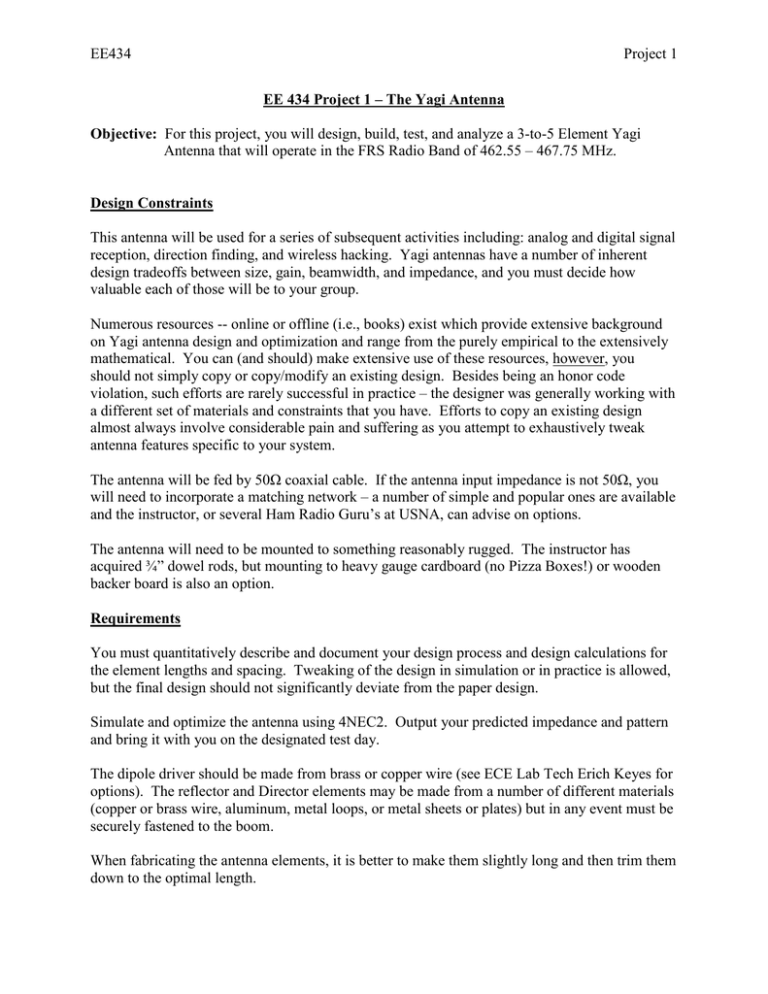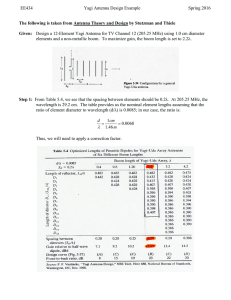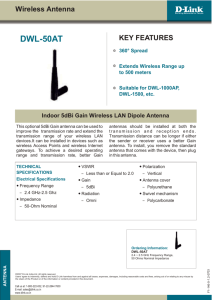EE434 Project 1
advertisement

EE434 Project 1 EE 434 Project 1 – The Yagi Antenna Objective: For this project, you will design, build, test, and analyze a 3-to-5 Element Yagi Antenna that will operate in the FRS Radio Band of 462.55 – 467.75 MHz. Design Constraints This antenna will be used for a series of subsequent activities including: analog and digital signal reception, direction finding, and wireless hacking. Yagi antennas have a number of inherent design tradeoffs between size, gain, beamwidth, and impedance, and you must decide how valuable each of those will be to your group. Numerous resources -- online or offline (i.e., books) exist which provide extensive background on Yagi antenna design and optimization and range from the purely empirical to the extensively mathematical. You can (and should) make extensive use of these resources, however, you should not simply copy or copy/modify an existing design. Besides being an honor code violation, such efforts are rarely successful in practice – the designer was generally working with a different set of materials and constraints that you have. Efforts to copy an existing design almost always involve considerable pain and suffering as you attempt to exhaustively tweak antenna features specific to your system. The antenna will be fed by 50Ω coaxial cable. If the antenna input impedance is not 50Ω, you will need to incorporate a matching network – a number of simple and popular ones are available and the instructor, or several Ham Radio Guru’s at USNA, can advise on options. The antenna will need to be mounted to something reasonably rugged. The instructor has acquired ¾” dowel rods, but mounting to heavy gauge cardboard (no Pizza Boxes!) or wooden backer board is also an option. Requirements You must quantitatively describe and document your design process and design calculations for the element lengths and spacing. Tweaking of the design in simulation or in practice is allowed, but the final design should not significantly deviate from the paper design. Simulate and optimize the antenna using 4NEC2. Output your predicted impedance and pattern and bring it with you on the designated test day. The dipole driver should be made from brass or copper wire (see ECE Lab Tech Erich Keyes for options). The reflector and Director elements may be made from a number of different materials (copper or brass wire, aluminum, metal loops, or metal sheets or plates) but in any event must be securely fastened to the boom. When fabricating the antenna elements, it is better to make them slightly long and then trim them down to the optimal length. EE434 Project 1 Grading Be prepared to demonstrate and discuss the following: • • • • • • The approach and tradeoffs you used in your antenna design and a quantitative approach to your initial design. Documentation of the iterative design process used to optimize the antenna in 4NEC2. A final design drawing that shows the complete antenna geometry, including all dimensions and materials. The predicted antenna pattern plots and antenna impedance form 4NEC2. The measured antenna pattern and impedance from the USNA Antenna Chamber. Compare your results to generally available design guidelines and resources. EE434 Project 1 Just like the project report, each presentation should address the following three topics: Introduction & Problem Statement. Provide a brief overview/need/motivation of your project and address the need/motivation, goals, and objectives for the project. Background. Provide a brief overview of any necessary background material. Use this section to educate your audience on any specifics they will need to know to understand the technical details of your project component (e.g., introduce propagation, channel models, link budgets, etc.). Limit to a maximum of 1/3 of your presentation, or 3 slides. Methodology/Approach. Describe briefly how you went about addressing your problem. Analysis, simulation, design, and code examples should be presented in this section. Results. 1-2 Slides that summarize the major findings and results of your work. Compare predicted vs. measured data, predicted vs. actual performance, and share any results that demonstrate whether your project was successful. Discussion & Conclusion. Discuss what worked and what didn’t work. If something was unsuccessful, explain why it was unsuccessful and what (if anything) needs to be addressed/improved/corrected to make it successful. If you had success, explain how your success fits into the broader context of the problem you are addressing. EE434 Project 1 Team Members: ____________________________ Evaluator: _____________________ Score (0–5) Item 0 3 5 Introduction Not given Need, and objectives presented but incomplete Clear & concise “forest view” of project x1= Problem Overview Missing Present but not motivated or vague. Mission and expected outcome clearly motivated and articulated x1= Background Insufficient level of detail for design Incomplete description of important material, including channel models, link budgets, or system operations. Wireless system operation and associated models clearly articulated and tied together. x2= Engineering Requirements Missing Present but not justified, quantified, or too abstract Present, fully justified, and appropriately formed x2= Methodology Insufficient level of detail for design Some but not all of the approach is described; missing steps or incomplete information. Clearly described approach to analyzing the problem space and associated engineering process. x2= Design Architecture Insufficient level of detail for design Some but not all design decisions sufficiently described. Block diagrams & functional descriptions clearly provided. Design decisions justified. x3= Engineering Analysis Barely substantiate data, simulation, or predicted results; no discussion performance differences between predicted and tested. Some discussion of data, simulation, or predictions; delineated the origin of some performance differences between predicted and tested. Clearly and concisely discussed data, simulation, and predicted results and tied all three together. Clearly delineated the origin of performance differences; identified contributors. x4= Response to Questions Team is completely thrown or defensive Team struggled with some questions but maintained composure Answered questions readily and professionally x1= Slide Quality Completely illegible Some slides are difficult to read Slides are legible, correct, and visually appealing x2= Presence Mumbling and/or no eye contact Low energy but understandable and with eye contact Dynamic and charismatic x1= Late, not prepared, too long/short Proper timing, but presentation contains typos, seems rough, inadequate figure/slide titles. Presentation is polished, professional, and clearly delivered, clear & concise titles. x1= Professionalism Presentation Score: Weight Sum: Score



